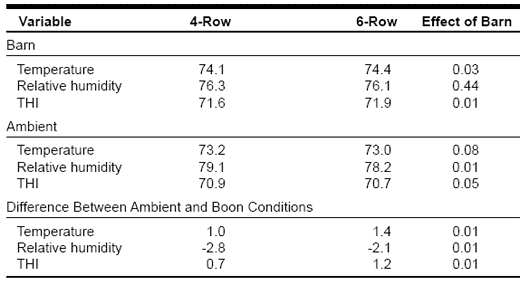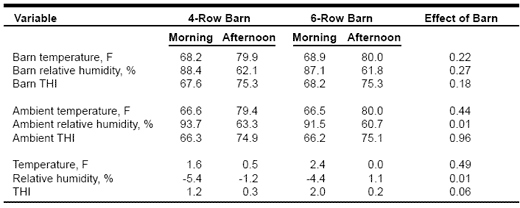Are cows housed in six-row barns more prone to heat stress?
Published: July 21, 2008
By: John F. Smith, Micheal J. Brouk, and Joseph P. Harner - Kansas State University Dairy Research & Extension News - Dairy Lines newsletter
Procedures
Temperature and humidity readings were collected from six freestall barns (three, six-row and three, four-row) on five farms, at four locations in each barn. Ambient temperature and humidity were measured at two locations near each freestall barn. HOBO data loggers, programmed to record every 15 minutes 24 hours a day, gathered the information continuously from June 9, 2000, until September 27, 2000. Respiration rates of 50 cows in each barn were collected from 6 to 8 a.m. and 2 to 4 p.m. for three days.
Results
Average temperature, humidity, and temperature humidity index (THI) of fourrow and six-row barns, and respiration measurements collected during the three days are listed in Table 1. Table 1 also contains average ambient temperature for four- and six-row barns.
Average temperature and THI were higher (P<.03) in six-row barns during the period in which respiration rates were measured. There were differences (P<.05) in ambient relative humidity and THI between the locations of four- and six-row barns. Although statistical differences exist in the number of variables associated with temperature and humidity between four- and six-row barns, numerically these differences are minimal and may not be biologically significant.
In Table 2 the averages for morning and afternoon observation periods are exhibited for barn type. Respiration rates were higher (P<.05) in the morning, afternoon, and on average in sixrow barns than they were in four-row barns. Average morning and afternoon respiration rates are presented in Table 3. Respiration rates are presented by day in Table 4.
Table 1. Average Temperature, Relative Humidity and THI of Four-Row and Six Row Barns for Three Days and Respiration Measurements

Table 2. Average Morning and Afternoon Temperature and Humidity and THI During Respiration Measurements for Four- and Six-Row Freestall Barns.

Table 3. Average Morning and Afternoon Respiration Rates of Cows Housed in Four-Row and Six-Row Freestall Barns located in NW Iowa.

Table 4. Afternoon Respiration Rates, Barn Temperature, Relative Humidity and THI at Time of Respiration Measurements

Conclusions
Temperature, relative humidity, and THI were higher in sixrow than four-row freestall barns when compared to the surrounding air. Respiration rates were higher in six-row versus four-row buildings. The difference in temperature and humidity variables may not explain differences in respiration rates. It is possible that a relationship exists between animal density and social interaction and that this could increase respiration rates when animal density is increased. It also may be possible that more mechanical ventilation is required to keep cows comfortable in six-row barns.
Related topics:
Recommend
Comment
Share

Would you like to discuss another topic? Create a new post to engage with experts in the community.




.jpg&w=3840&q=75)